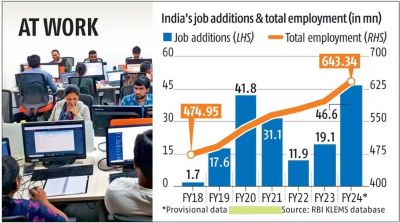Context:
Recently, citing a Reserve Bank of India (RBI) report that said that 8 crore jobs have been created in the last 3-4 years, the Prime Minister accused the Opposition of creating false narratives about unemployment. He also said that a lot of infrastructure projects are coming up, which will create more jobs. He also highlighted upcoming infrastructure projects expected to generate more jobs. This response was aimed at addressing concerns raised by financial institutions, such as Citigroup, about inadequate employment generation in India.
Discrepancies in Employment Data
Conflicting Reports and Statements
The Prime Minister referenced the RBI’s ‘Data Manual’ from July 7, 2024, which details the India KLEMS (K: Capital, L: Labour, E: Energy, M: Materials and S: Services) Database. This dataset includes measures of Gross Value Added, Labour Employment, and more, covering 27 industries. Despite this, the State Bank of India (SBI) released a report claiming 8.9 crore jobs were created between FY14-FY23 and 6.6 crore from FY04-FY14, with the total labour force at 59.7 crore. This contrasted sharply with the Centre for Monitoring Indian Economy (CMIE), which reported a rise in the unemployment rate to 9.2% in June 2024, contrary to the official narrative.
Public Perception and Data Discrepancies
Conflicting data has left the public confused about unemployment. For example, 47 lakh applicants competed for 60,000 constable positions in Uttar Pradesh in February, and 1.25 crore applied for the Railway Recruitment Board’s exam in 2022. Protests over the Agnipath scheme in 2022 further underscored the grim situation for educated youth. This disparity between public perception and official data highlights the need for clearer insights.
The KLEMS Data and Its Limitations
The India KLEMS Database, which is intended to monitor productivity growth, uses data from Employment and Unemployment Surveys (EUS) and the Periodic Labour Force Survey (PLFS). However, KLEMS does not independently estimate employment but relies on existing datasets. This reliance on official data may lead to discrepancies between KLEMS and other employment figures provided by government agencies.
Why Varying Employment Estimates?
Economic Shocks in Unorganised Sector
India’s complex economic structure and lack of reliable data contribute to varying employment estimates. The economy includes both organised and unorganised sectors, with the latter employing 94% of the labour force. Data for the unorganised sector is sparse and outdated, as the last Census was conducted in 2011 and the Urban Frame Survey (UFS) data are from 2012-17. Additionally, the unorganised sector was significantly impacted by recent economic shocks like demonetisation, the introduction of GST, the Non-Banking Financial Companies crisis, and the COVID-19 pandemic.
Challenges in Employment Surveys
The Annual Survey of Unincorporated Sector Enterprises (ASUSE) survey, which aims to estimate employment in the unorganised sector, has limitations due to outdated data and structural changes caused by recent economic shocks. This survey may not accurately reflect closures and changes in establishments, potentially skewing employment estimates.
Variations in PLFS and CMIE Data
The PLFS and CMIE reports differ significantly due to variations in definitions. The CMIE follows the International Labour Organization's definition, counting only those earning income from work as employed. In contrast, PLFS counts anyone working, regardless of income. This discrepancy leads to PLFS reporting a higher labour force participation rate (50%-55%) compared to CMIE’s (40%-45%). The PLFS may also include disguised and under-employed individuals, while CMIE accounts for those who have given up job searching.

Addressing Unemployment Issues
Understanding the Challenges:
● Unorganised Sector Woes: India's vast unorganised sector, employing 94% of the workforce, lacks reliable data and faces challenges like demonetisation, GST, and economic slowdowns. This sector needs targeted interventions to create sustainable jobs.
● Formalisation of Jobs: Many jobs in the unorganised sector remain informal, lacking social security benefits and job security. Measures to incentivize formalisation can improve working conditions and attract talent.
● Outdated Surveys: Reliance on dated data like the 2011 Census and 2012-17 Urban Frame Survey (UFS) paints an inaccurate picture of employment dynamics in a rapidly changing economy. Regular and robust surveys are essential for effective policymaking.
● Skill Mismatches: The skill gap between job seekers and industry requirements remains a significant barrier. Focusing on skill development programs aligned with evolving industry needs is crucial.
Policy Recommendations:
● Improved Data Collection: Investing in robust and regular data collection methods across both organised and unorganised sectors is vital. Regular surveys and data analysis using standard methodologies will provide a clearer picture of employment trends.
● Skill Development Initiatives: Increased government and industry collaboration in developing job-linked skill development programs will equip young people with the skills needed to thrive in the job market such as Skill India Initiative.
● Entrepreneurship Promotion: Fostering an ecosystem that promotes entrepreneurship can create employment opportunities. This could involve access to credit, incubation facilities, and mentorship programs for aspiring entrepreneurs.
● Focus on Micro, Small and Medium Enterprises (MSMEs): MSMEs are a significant source of job creation. Providing them with easier access to credit, simplified regulations, and infrastructure support can promote their growth and generate more employment opportunities.
● Social Safety Nets: Strengthening social safety nets through programs like unemployment insurance or social welfare schemes can provide a safety net for those experiencing job losses.
Conclusion
The frequent public reports of youth struggling with employment and issues in examinations highlight the disconnect between official data and ground-level realities. Government officials have been criticised for using flawed data and denying employment problems. Acknowledging and addressing these issues is crucial to avoid growing frustration among the youth and to implement effective solutions.The confusion over unemployment statistics stems from differences in data sources and definitions. Effective policy responses require accurate and updated data, along with a recognition of the limitations of current surveys and datasets. Addressing these issues is essential for developing strategies that genuinely address unemployment and support the labour market.
|
Probable Questions for UPSC Mains 1. Evaluate the implications of the discrepancies between different employment data sources such as the RBI's KLEMS Database, CMIE reports, and PLFS data on India's employment policy. How can the government reconcile these differences to formulate effective employment strategies? (10 Marks, 150 Words) 2. Discuss the impact of India's large unorganised sector and outdated survey data on employment estimates. What are the key challenges in accurately assessing employment in this sector, and what policy measures can be implemented to improve data reliability and employment outcomes? (15 Marks, 250 Words) |
Source: The Hindu







